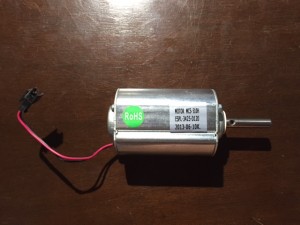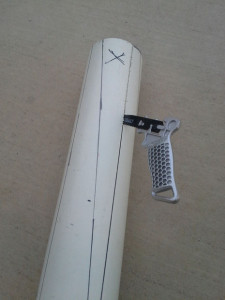My motor has finally arrived! It is a 120V 2500rpm DC motor wind turbine generator, and it was only $22 on Amazon. It is actually much smaller than I originally imagined, measuring about 4.5 inches long. I have attached a picture of the motor below.

120V 2500 rpm motor
The reviews I read online for this motor are all positive, and one user said he can get up to 10V by just spinning the shaft with his hand! With blades attached, it should easily get over 12V in the wind, and much more on a strong windy day.
I am going to head to McGuckins this weekend to pick up the PVC pipe for the blades. I am getting some help from an online resource, which suggests getting 2′ long 4″ diameter PVC pipes and cutting them diagonally with a hand saw. Below is an example of how I will cut out the blades. The larger diameter of the PVC will allow the turbine blades to turn with ease in less wind.

I also need to create a hub for the blades to connect to the shaft of the motor. For this, I will be using a saw blade (cheap form of circular metal) to attach the blades to. I will also need a spindle adaptor and a saw blade arbor adaptor to transmit the rotation from the blades to the shaft. Once I have assembled these mechanical components, I will troubleshoot how to store the electricity that is produced.
Resources:
http://www.instructables.com/id/Wind-Generator-Design-4/

3 Comments. Leave new
Great idea with the PVC pipes! Its a simple, quick, and inexpensive solution to a semi-complicated problem. Have you thought more about the aesthetic you’re going for? What’s the scale of the whole windmill? That’s a pretty small motor, but that’s impressive that you could potentially get 10-12 V out of it. Do you know what kind of current you’d get? Brendan and Ryan both have great ideas with the hub and flywheels. It might be best to have it charge some kind of battery in order to store the power produced. Another possibility could be to power some kind of small appliance or something using that, but that mostly depends on the current. Best of luck with getting all the pieces together. Try using a Dremel tool to make the sanding a bit quicker and easier.
Just a quick comment on the hub discussion: Metal Supermarkets in Westminster is having a sale (50% off remnant prices) on all of their sheet drops. I’ve been using them for all of the aluminum in my project. I was able to get 1 ft. square of 1/4in aluminum for $6. They have racks and racks of material of varying thickness and grade. Take this to the shop and run a preprogrammed circular toolpath on the mill and you are golden. Could be easier than trying the fit a square peg in a round hole with the repurposed saw blade, plus it will solve all of your inertia problems without having to retrofit.
The use of a pvc pipe to build the blades out of is genius, you get all the curvature in a lightweight package that has enough stiffness to maintain shape in the wind. Two quick ideas, instead of a saw blade, or in addition to, use some large (2-3 inch) washers stacked together, the additional weight will act as a flywheel and store energy allowing smoother voltage curves. Second sanding down the pvc blades giving the tips less mass, should allow for easier initial turning.